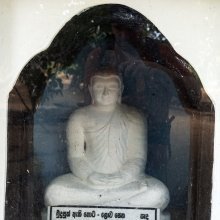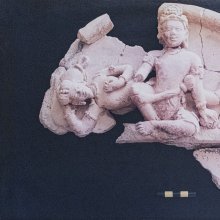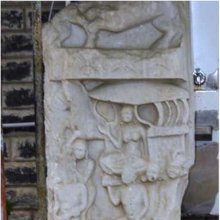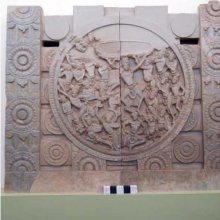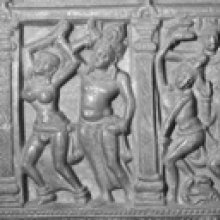Siddhartha, Siddhārtha, Siddhārthā, Siddha-artha: 35 definitions
Introduction:
Siddhartha means something in Buddhism, Pali, Hinduism, Sanskrit, Jainism, Prakrit, the history of ancient India, Hindi, biology. If you want to know the exact meaning, history, etymology or English translation of this term then check out the descriptions on this page. Add your comment or reference to a book if you want to contribute to this summary article.
Images (photo gallery)
(+7 more images available)
In Hinduism
Ayurveda (science of life)
Cikitsa (natural therapy and treatment for medical conditions)
Source: Wisdom Library: Ayurveda: CikitsaSiddhārtha (सिद्धार्थ) is a Sanskrit word referring to the “white mustard”, a species of plant from the Brassicaceae (cabbage) family. It is used throughout Ayurvedic literature such as the Caraka-saṃhitā and the Suśruta-saṃhitā. The official botanical name is Brassica campestris.
This plant (Siddhārtha ) is also mentioned as a medicine used for the treatment of all major fevers, as described in the Jvaracikitsā (or “the treatment of fever”) which forms the first chapter of the Sanskrit work called Mādhavacikitsā.
Kalpa (Formulas, Drug prescriptions and other Medicinal preparations)
Source: Shodhganga: Edition translation and critical study of yogasarasamgrahaSiddhārtha (सिद्धार्थ) refers to the medicinal plant known as “Brassica alba Boiss.” and is dealt with in the 15th-century Yogasārasaṅgraha (Yogasara-saṅgraha) by Vāsudeva: an unpublished Keralite work representing an Ayurvedic compendium of medicinal recipes. The Yogasārasaṃgraha [mentioning siddhārtha] deals with entire recipes in the route of administration, and thus deals with the knowledge of pharmacy (bhaiṣajya-kalpanā) which is a branch of pharmacology (dravyaguṇa).

Āyurveda (आयुर्वेद, ayurveda) is a branch of Indian science dealing with medicine, herbalism, taxology, anatomy, surgery, alchemy and related topics. Traditional practice of Āyurveda in ancient India dates back to at least the first millenium BC. Literature is commonly written in Sanskrit using various poetic metres.
Vastushastra (architecture)
Source: Wisdom Library: Vāstu-śāstraSiddhārtha (सिद्धार्थ) refers to a type of temple (prāsāda) classified, according to Samarāṅgaṇasūtradhāra chapter 57. The temple is mentioned as one of the six temples being a favorite of Śiva. The Samarāṅgaṇasūtradhāra is an 11th-century encyclopedia dealing with various topics from the Vāstuśāstra.

Vastushastra (वास्तुशास्त्र, vāstuśāstra) refers to the ancient Indian science (shastra) of architecture (vastu), dealing with topics such architecture, sculpture, town-building, fort building and various other constructions. Vastu also deals with the philosophy of the architectural relation with the cosmic universe.
Purana and Itihasa (epic history)
Source: archive.org: Puranic Encyclopedia1) Siddhārtha (सिद्धार्थ).—A King. This King was the rebirth of the asura Krodhavaśa. (Bhārata, Ādi Parva, Chapter 67, Verse 60).
2) Siddhārtha (सिद्धार्थ).—A warrior of Subrahmaṇya. (Mahābhārata Śalya Parva, Chapter 45, Verse 64).
3) Siddhārtha (सिद्धार्थ).—The name of Buddha in his childhood. (See under Buddha).
4) Siddhārtha (सिद्धार्थ).—A minister of King Daśaratha. (Vālmīki Rāmāyaṇa, Ayodhyā Kāṇḍa, Sarga 36).
Source: Cologne Digital Sanskrit Dictionaries: The Purana Index1a) Siddhārtha (सिद्धार्थ).—A son of Maṇibhadra and Puṇyajanī: an Yakṣa.*
- * Brahmāṇḍa-purāṇa III. 7. 122; Vāyu-purāṇa 69. 154.
1b) A son of Suddhodana.*
- * Matsya-purāṇa 271. 12.
Siddhārtha (सिद्धार्थ) is a name mentioned in the Mahābhārata (cf. I.61.55) and represents one of the many proper names used for people and places. Note: The Mahābhārata (mentioning Siddhārtha) is a Sanskrit epic poem consisting of 100,000 ślokas (metrical verses) and is over 2000 years old.

The Purana (पुराण, purāṇas) refers to Sanskrit literature preserving ancient India’s vast cultural history, including historical legends, religious ceremonies, various arts and sciences. The eighteen mahapuranas total over 400,000 shlokas (metrical couplets) and date to at least several centuries BCE.
Jyotisha (astronomy and astrology)
Source: Wisdom Library: Brihat Samhita by VarahamihiraSiddhārtha (सिद्धार्थ) refers to the fifty-third of the sixty-year cycle of Jupiter, according to the Bṛhatsaṃhitā (chapter 8), an encyclopedic Sanskrit work written by Varāhamihira mainly focusing on the science of ancient Indian astronomy astronomy (Jyotiṣa).—Accordingly, “The five years of the eleventh yuga are—1. Piṅgala, 2. Kālayukta, 3. Siddhārtha, 4. Raudra, 5. Durmati. In the first year there will be much rain and fear from thieves and mankind will suffer from consumption of the lungs and the like asthmatic complaints. In the year Kālayukta mankind will suffer from various evils; but in Siddhārtha they will be happy in more ways than one. In the year Raudra mankind will suffer much and there will be loss and ruin in the land. In Durmati there will be moderate rain”.
Source: academia.edu: Tithikarmaguṇa in GārgīyajyotiṣaSiddhārthā (सिद्धार्था).—Accordingly to the Bṛhatsaṃhitā , “(39) The New Moon is Siddhārthā. The worship of ancestors is praised on this tithi. One should enter sanctuaries (gokulāni) where there are holy rites and fire rites. (40) One should appoint a Purohita and perform sacrificial rites, make offerings and occasional oblations. The ancestors are the deity on this tithi”.

Jyotisha (ज्योतिष, jyotiṣa or jyotish) refers to ‘astronomy’ or “Vedic astrology” and represents the fifth of the six Vedangas (additional sciences to be studied along with the Vedas). Jyotisha concerns itself with the study and prediction of the movements of celestial bodies, in order to calculate the auspicious time for rituals and ceremonies.
Kavya (poetry)
Source: Wisdom Library: KathāsaritsāgaraSiddhārtha (सिद्धार्थ) is the son of one of the ministers of king Candraprabha, appointed to his son, Sūryaprabha, according to the Kathāsaritsāgara, chapter 44. Accordingly, as Vajraprabha said to Naravāhanadatta: “... and then, when he [Sūryaprabha] was sixteen years old, and captivated the subjects by his virtues, his father, Candraprabha, appointed him Crown Prince, and he gave him the sons of his own ministers, many in number, Bhāsa, Prabhāsa, Siddhārtha, Prahasta and others”.
In chapter 47, Siddhārtha is considered a chief of a host of great warriors (mahāratha) in Sunītha and Sūryaprabha’s army. Accordingly, as the Asura Maya explained the arrangement of warriors in Sunītha’s army: “... Viśvaruci, and Bhāsa and Siddhārtha, these three ministers of Sūryaprabha, are chiefs of hosts of great warriors”.
The story of Siddhārtha was narrated by the Vidyādhara king Vajraprabha to prince Naravāhanadatta in order to relate how “Sūryaprabha, being a man, obtain of old time the sovereignty over the Vidyādharas”.
The Kathāsaritsāgara (‘ocean of streams of story’), mentioning Siddhārtha, is a famous Sanskrit epic story revolving around prince Naravāhanadatta and his quest to become the emperor of the vidyādharas (celestial beings). The work is said to have been an adaptation of Guṇāḍhya’s Bṛhatkathā consisting of 100,000 verses, which in turn is part of a larger work containing 700,000 verses.
Source: archive.org: Naisadhacarita of SriharsaSiddhārtha (सिद्धार्थ) refers to “mustard seed”, and is mentioned in the Naiṣadha-carita 10.6.—Cf. Kādambarī (Pūrvabhāga).

Kavya (काव्य, kavya) refers to Sanskrit poetry, a popular ancient Indian tradition of literature. There have been many Sanskrit poets over the ages, hailing from ancient India and beyond. This topic includes mahakavya, or ‘epic poetry’ and natya, or ‘dramatic poetry’.
Shaivism (Shaiva philosophy)
Source: SOAS University of London: Protective Rites in the Netra TantraSiddhārtha (सिद्धार्थ) or Siddhārthaka refers to “white mustard”, according to the Netratantra of Kṣemarāja: a Śaiva text from the 9th century in which Śiva (Bhairava) teaches Pārvatī topics such as metaphysics, cosmology, and soteriology.—Accordingly, [verse 15.4cd-7ab, while describing protection rituals]—“Since all Rakṣasas run away and are killed, then O Devi, I call [white mustard seeds] rakṣoghna. They spread on Earth and in all battles between demons and the chiefs of gods. [Mustard seeds] are employed as killers of villains in order to accomplish (siddhi) the destruction of enemies. Since their purpose is accomplished then they are called white mustard (siddhārthaka) on Earth. They take away pride in evil-minded spirits”.

Shaiva (शैव, śaiva) or Shaivism (śaivism) represents a tradition of Hinduism worshiping Shiva as the supreme being. Closely related to Shaktism, Shaiva literature includes a range of scriptures, including Tantras, while the root of this tradition may be traced back to the ancient Vedas.
In Buddhism
Mahayana (major branch of Buddhism)
Source: Wisdom Library: Maha Prajnaparamita SastraSiddhartha (सिद्धर्थ) is a synonym for the Buddha according to the 2nd century Mahāprajñāpāramitāśāstra (chapter IV). His parents named him Si ta t’o (Siddhartha) which, in the language of the Ts’in, means “profit-realized one”.

Mahayana (महायान, mahāyāna) is a major branch of Buddhism focusing on the path of a Bodhisattva (spiritual aspirants/ enlightened beings). Extant literature is vast and primarely composed in the Sanskrit language. There are many sūtras of which some of the earliest are the various Prajñāpāramitā sūtras.
General definition (in Buddhism)
Source: Wisdom Library: BuddhismSiddhartha (meaning he who has attained his goal) was the founder of Buddhism. His family name was Gauthama. He was a prince, son of King Suddhodhana and Queen Maya of the Kingdom of the 'Sakyas' whose capital was Kapilavastu. He was born about 567 B.C. He became "Buddha" or the enlightened one, later in his life and formed the religion Buddhism.
Source: Buddhist Door: GlossarySiddhartha in Sanskrit, Siddhattha in Pali. The given name of Shakyamuni when he was born to the Prince Suddhodana. The name means "wish fulfilled".Source: Shambala Publications: GeneralSiddhārtha Gautama Skt. (Pali, Siddhatta Gotama); founder of Buddhism, the historical Buddha. Siddhārtha was born in 566 or 563 BCE into a noble family of the Shākya clan in Kapilavastu, a city in present-day Nepal. His father, Suddhodana, was the head of the Shākyas; his mother, Māyādevī, who brought Siddhārtha into the world in the Lumbinī Grove, died seven days after his birth. Siddhārtha was brought up by his aunt on his mother’s side, Mahāprajāpatī. Carefully raised in wealthy circumstances, Siddhārtha married Yashodharā at the age of sixteen. At twenty-nine, after the birth of his son, Rāhula, he entered homelessness and attended on various ascetic teachers, without, however, reaching his goal, spiritual liberation. Thus he gave up the ascetic way of life and turned to meditation. At thirty-five he realized complete enlightenment, awakening (bodhi). After remaining silent at the beginning—because he was aware of the impossibility of communicating directly what he had experienced in enlightenment—he began at the request of others to expound insights drawn from his experience of enlightenment. He spent the rest of his life moving from place to place teaching, and a great number of disciples gathered around him. Siddhārtha Gautama, who came to be known by the name Shākyamuni (Sage of the Shākya Clan), died at the age of eighty after eating some spoiled food.
In Jainism
Jain philosophy
Source: archive.org: Anekanta Jaya Pataka of Haribhadra SuriSiddhārtha (सिद्धार्थ) is the name of an ancient king Kṣatriyakuṇḍa, as occurring in the Anekāntajayapatākā-prakaraṇa, a Śvetāmbara Jain philosophical work written by Haribhadra Sūri.—[Cf. Vol. I, P. 199, l. 25]—Siddhārtha was a king of Kṣatriya-kuṇḍa. His wife’s name was Triśalā. She gave birth to Lord Mahavīra.
-
General definition (in Jainism)
Source: Wisdom Library: Jainism1) Siddhartha (सिद्धर्थ) is the mother of Abhinandana, the fourth of twenty-four Tīrthaṅkaras in Janism, according to the Ācāradinakara. The husband of Siddhartha is is Saṃvara.
2) Siddhārtha (सिद्धार्थ) is the father of Mahāvīra, the twenty-fourth of twenty-four Tīrthaṅkaras in Janism, according to the Ācāradinakara. The wife of Siddhārtha is Triśalā according to Śvetāmbara or Priyakāriṇī according to Digambara.
The Ācāradinakara is a 14th century work on Jain conduct written by Vardhamāna Sūri. A Tīrthaṅkara is an enlightened being who has conquered saṃsāra (cycle of birth and death), leaving behind him a path for others to follow. It is an ancient Jain practice to worship the Tīrthaṅkara’s parents in various rites, such as the pratiṣṭhāvidhi.
Source: archive.org: The Jaina Iconography1) Siddhārthā (सिद्धार्था) is the name of the mother of Abhinandananātha: the fourth of twenty-four Tīrthaṃkaras or Jinas, commonly depicted in Jaina iconography.—In Jaina history of pontiffs, Abhinandananātha’s place is Ayodbyā. His father’s name is King Svayaṃvara and mother’s name Siddhārthā. He attained mokṣa accompanied by a thousand monks, as, indeed, did all the first eleven Tīrthaṃkaras except Supārśvanātha.
2) Siddhārtha (सिद्धार्थ) is the father of Mahāvīra: the last of twenty-four Tīrthaṃkaras or Jinas, commonly depicted in Jaina iconography.—Vardhamāna was born of a royal family of Videha or North Bihār, his father Siddhārtha, being the ruling prince of Kuṇḍapura, the abode of the Nāta or Nāya clan, his mother is known by the name of Triśalā.
Source: archive.org: Trisastisalakapurusacaritra1) Siddhārtha (सिद्धार्थ) is the name of an ancient city, according to chapter 4.1 [śreyāṃsanātha-caritra] of Hemacandra’s 11th century Triṣaṣṭiśalākāpuruṣacaritra: an ancient Sanskrit epic poem narrating the history and legends of sixty-three illustrious persons in Jainism.
Accordingly:—“[...] Celebrating an eight-day festival in honor of the images of the eternal Arhats, the lords of the gods and Asuras went to their respective abodes. On the next day the Supreme Lord broke his fast with rice-pudding in the city Siddhārtha in the house of King Nanda. Then the gods made the five things—the stream of treasure, etc., and King Nanda made a jeweled platform over the place of the Master’s feet. From that place the Master, unhindered, set out to wander like the wind in villages, mines, cities, et cetera. [...]”.
2) Siddhārtha (सिद्धार्थ) is the name of a vidyā subdued by Bibhīṣaṇa, according to the Jain Ramayana and chapter 7.1 [origin of the rākṣasavaṃśa and vānaravaṃśa].—Accordingly, “[...] Rāvaṇa, knowing the highest good, not considering it worthless, remained motionless like a high mountain, absorbed in preeminent meditation. ‘Well done! Well done!’ was the cry of gods in the sky, and the Yakṣa-servants departed quickly, terrified. [...] Five vidyās, Saṃvṛddhi, Jṛmbhaṇī, Sarvāhāriṇī, Vyomagāminī, Indrāṇī, were subdued by Kumbhakarṇa. Four vidyās, Siddhārthā, Śatrudamanī, Nirvyāghātā, Khagāminī, were subdued by the younger brother of Kumbhakarṇa. [...]”.

Jainism is an Indian religion of Dharma whose doctrine revolves around harmlessness (ahimsa) towards every living being. The two major branches (Digambara and Svetambara) of Jainism stimulate self-control (or, shramana, ‘self-reliance’) and spiritual development through a path of peace for the soul to progess to the ultimate goal.
India history and geography
Source: Piotr Balcerowicz: Royal Patronage of JainismSiddhārtha (सिद्धार्थ) is the name of one of the sixteen Jain Ācāryas (teachers) mentioned in the inscription of Pārśvanātha Bastī (which was engraved in 522 Śaka era, i.e. Vikram 657 years and 1127 V.N.).—Accordingly, “[...] when a calamity in Ujjayinī lasting for a twelve-year period was foretold by Bhadrabāhu-svāmin, who comes from an impeccable old race which is a lineage of great men coming in succession within the lineage of teachers [viz., Siddhārtha], and who possesses the knowledge of the truth of the Great Omens (mahānimitta) in eight parts (canonical books, aṅga), who sees the three times (past, present and future), after he had seen it with the help of the omens, the whole congregation [of Jaina monks] set out from the northern region towards the southern region. Gradually, they [viz., Siddhārtha] reached a locality of several hundred villages, full of happy people, riches, gold, grain, herds of cows, buffaloes, goats and sheep. [...]”.

The history of India traces the identification of countries, villages, towns and other regions of India, as well as mythology, zoology, royal dynasties, rulers, tribes, local festivities and traditions and regional languages. Ancient India enjoyed religious freedom and encourages the path of Dharma, a concept common to Buddhism, Hinduism, and Jainism.
Biology (plants and animals)
Source: Wisdom Library: Local Names of Plants and DrugsSiddhartha in the Sanskrit language is the name of a plant identified with Sinapis alba L. from the Brassicaceae (Mustard) family having the following synonyms: Brassica foliosa, Brassica alba, Sinapis foliosa. For the possible medicinal usage of siddhartha, you can check this page for potential sources and references, although be aware that any some or none of the side-effects may not be mentioned here, wether they be harmful or beneficial to health.
Source: Google Books: CRC World Dictionary (Regional names)Siddhartha in India is the name of a plant defined with Shorea assamica in various botanical sources. This page contains potential references in Ayurveda, modern medicine, and other folk traditions or local practices It has the synonym Shorea siamensis Miq. var. borealis Y.K. Yang & J.K. Wu (among others).
Example references for further research on medicinal uses or toxicity (see latin names for full list):
· Annales Museum Botanicum Lugduno-Batavi (1863)
· Flora of the British India (1874)
If you are looking for specific details regarding Siddhartha, for example health benefits, chemical composition, pregnancy safety, diet and recipes, extract dosage, side effects, have a look at these references.

This sections includes definitions from the five kingdoms of living things: Animals, Plants, Fungi, Protists and Monera. It will include both the official binomial nomenclature (scientific names usually in Latin) as well as regional spellings and variants.
Languages of India and abroad
Sanskrit dictionary
Source: DDSA: The practical Sanskrit-English dictionarySiddhārtha (सिद्धार्थ).—a. one who has accomplished his desired object, successful. (-rthaḥ) 1 white mustard; यन्त्रस्थसिद्धार्थपदाभिषेकं लब्ध्वाप्यसिद्धार्थममन्यत स्वम् (yantrasthasiddhārthapadābhiṣekaṃ labdhvāpyasiddhārthamamanyata svam) N.1.6; अविरललग्नगौरसिद्धार्थकप्रकारतया काञ्चनरसखचितामिव मालाम् (aviralalagnagaurasiddhārthakaprakāratayā kāñcanarasakhacitāmiva mālām) K. (Pūrvabhāga); Bhāgavata 4.9.59.
2) Name of Śiva.
3) of the great Buddha.
Siddhārtha is a Sanskrit compound consisting of the terms siddha and artha (अर्थ).
Source: Cologne Digital Sanskrit Dictionaries: Edgerton Buddhist Hybrid Sanskrit DictionarySiddhārtha (सिद्धार्थ).—(1) (= Pali Siddhattha), personal name of Śākyamuni (Buddha; in Mahāvastu and Lalitavistara more commonly Sarvārthasiddha): Mahāvyutpatti 49; 3603 (here in a list of ‘cakra- vartin kings’ but following the names of his Śākyan elders); Gaṇḍavyūha 439.2; Mahāvastu ii.75.19 (after Sarvārthasiddha, 18); iii.330.7 (mss.); Lalitavistara 209.3; 226.17; 252.6; (2) name of another, future Buddha: Mahāvastu iii.330.8; but I believe the passage is cor- rupt, and that actually Śākyamuni is here referred to a second time (as well as in line 7, see above); note that Maitreya is named next in line 8; (3) name of a son of Māra (favorable to the Bodhisattva): Lalitavistara 312.21; (4) name of a yakṣa: Mahā-Māyūrī 69.
--- OR ---
Siddhārthā (सिद्धार्था).—name of a devakumārikā in the eastern quarter: Lalitavistara 388.9 = Mahāvastu iii.306.8.
Source: Cologne Digital Sanskrit Dictionaries: Shabda-Sagara Sanskrit-English DictionarySiddhārtha (सिद्धार्थ).—mfn.
(-rthaḥ-rthā-rthaṃ) Successful, prosperous. m.
(-rthaḥ) 1. The father of the last and most celebrated Jina or Jaina teacher of the present era. 2. White mustard. 3. A name of Sakya-sinha or Bud'dha. f.
(-rthā) The mother of the fourth Jina. E. siddha complete, &c., and artha meaning or wealth.
Source: Cologne Digital Sanskrit Dictionaries: Benfey Sanskrit-English DictionarySiddhārtha (सिद्धार्थ).—i. e. siddha -artha, I. adj. One who has obtained his aim,
Siddhārtha (सिद्धार्थ).—[adjective] = [preceding] or leading to the goal, effective, powerful; [masculine] [Epithet] of Buddha.
Source: Cologne Digital Sanskrit Dictionaries: Aufrecht Catalogus CatalogorumSiddhārtha (सिद्धार्थ) as mentioned in Aufrecht’s Catalogus Catalogorum:—poet. [Subhāshitāvali by Vallabhadeva]
Source: Cologne Digital Sanskrit Dictionaries: Monier-Williams Sanskrit-English Dictionary1) Siddhārtha (सिद्धार्थ):—a See col. 3.
2) [from siddha > sidh] b mf(ā)n. one who has accomplished an aim or object, successful, prosperous, [Mahābhārata; Kāvya literature] etc.
3) [v.s. ...] leading to the goal, efficient, efficacious, [Harivaṃśa; Rāmāyaṇa]
4) [v.s. ...] one whose aim or intention is known, [cf. Lexicographers, esp. such as amarasiṃha, halāyudha, hemacandra, etc.]
5) [v.s. ...] m. ‘he who has fulfilled the object (of his coming)’, Name of the great Buddha (Gautama or Śākya-muni, founder of Buddhism), [Monier-Williams’ Buddhism 43]
6) [v.s. ...] of a Māra-putra, [Lalita-vistara]
7) [v.s. ...] of a Dānava, [Kathāsaritsāgara]
8) [v.s. ...] of one of Skanda’s attendants, [Mahābhārata]
9) [v.s. ...] of a king, [ib.]
10) [v.s. ...] of a councillor of Daśa-ratha, [Rāmāyaṇa]
11) [v.s. ...] of the father of Mahā-vīra (the 24th Arhat of the present Avasarpiṇī), [Kathāsaritsāgara]
12) [v.s. ...] of a poet, [Subhāṣitāvali]
13) Siddhārthā (सिद्धार्था):—[from siddhārtha > siddha > sidh] f. Name of the mother of the 4th Arhat of the present Avasarpiṇī, [cf. Lexicographers, esp. such as amarasiṃha, halāyudha, hemacandra, etc.]
14) [v.s. ...] white mustard, [Suśruta; Varāha-mihira’s Bṛhat-saṃhitā] etc.
15) [v.s. ...] the Indian fig-tree, [cf. Lexicographers, esp. such as amarasiṃha, halāyudha, hemacandra, etc.]
16) [v.s. ...] the 53rd year in Jupiter’s cycle of 60 years, [Varāha-mihira’s Bṛhat-saṃhitā]
17) Siddhārtha (सिद्धार्थ):—[from siddha > sidh] n. ([scilicet] vāstu) a building with two halls (one to the west, and one to the south), [Varāha-mihira’s Bṛhat-saṃhitā]
Source: Cologne Digital Sanskrit Dictionaries: Yates Sanskrit-English DictionarySiddhārtha (सिद्धार्थ):—(rthaḥ) 1. m. A Jaina; Buddha; white mustard. 1. f. Mother of the 4th Jaina. a. Successful.
Source: DDSA: Paia-sadda-mahannavo; a comprehensive Prakrit Hindi dictionary (S)Siddhārtha (सिद्धार्थ) in the Sanskrit language is related to the Prakrit word: Siddhattha.
[Sanskrit to German]
Sanskrit, also spelled संस्कृतम् (saṃskṛtam), is an ancient language of India commonly seen as the grandmother of the Indo-European language family (even English!). Closely allied with Prakrit and Pali, Sanskrit is more exhaustive in both grammar and terms and has the most extensive collection of literature in the world, greatly surpassing its sister-languages Greek and Latin.
Hindi dictionary
Source: DDSA: A practical Hindi-English dictionarySiddhārtha (सिद्धार्थ):—(a) whose wishes have been fulfilled; (nm) preenlightenment name of Lord Buddha.
...
Kannada-English dictionary
Source: Alar: Kannada-English corpusSiddhārtha (ಸಿದ್ಧಾರ್ಥ):—
1) [noun] a man who has accomplished an aim or object succcessfully.
2) [noun] Gautama Buddha, the founder of Buddhism.
3) [noun] the plant Brassica alba of Brassicaceae family; white mustard plant.
4) [noun] small, round seed; white mustard.
5) [noun] a horse that is of white mustand colour.
Kannada is a Dravidian language (as opposed to the Indo-European language family) mainly spoken in the southwestern region of India.
See also (Relevant definitions)
Partial matches: Siddha, Artha.
Starts with: Siddharthabuddhi, Siddharthacarita, Siddharthah, Siddharthaka, Siddharthakarin, Siddharthamanin, Siddharthamati, Siddharthapriccha, Siddharthapricha, Siddharthapura, Siddharthasamhita, Siddharthavriksha.
Ends with: Asiddhartha, Prasiddhartha, Samsiddhartha, Sarvasiddhartha, Sarvvasiddhartha, Sitasiddhartha, Susiddhartha.
Full-text (+108): Sarvasiddhartha, Mahavira, Asiddhartha, Gautama, Trishala, Kapilavatthu, Siddharthakarin, Siddharthacarita, Siddharthamati, Kulabaddha, Yashodhara, Siddharthasamhita, Kundapura, Siddharthamanin, Siddharthapriccha, Channa, Siddhasambandha, Chhandak, Siddhattha, Kundagrama.
Relevant text
Search found 77 books and stories containing Siddhartha, Siddha-artha, Siddha-arthā, Siddhārtha, Siddhārthā; (plurals include: Siddharthas, arthas, arthās, Siddhārthas, Siddhārthās). You can also click to the full overview containing English textual excerpts. Below are direct links for the most relevant articles:
Siddhartha: Hermann Hesse’s ‘Prilgrim’s Progress’ < [October – December, 1998]
Hermann Hesse’s Siddhartha and ‘The Ancient < [July – September, 1995]
The Gardener < [December 1943]
Bhagavati-sutra (Viyaha-pannatti) (by K. C. Lalwani)
Part 3 - On patriarchs < [Chapter 5]
Part 21 - On the course of life of the non-restrained < [Chapter 1]
Trishashti Shalaka Purusha Caritra (by Helen M. Johnson)
Part 4: Description of queen Siddhārthā (Abhinandana’s mother) < [Chapter II - Abhinandanacaritra]
Part 5: Birth of Abhinandana < [Chapter II - Abhinandanacaritra]
Part 20: Bharata’s pūjā and stutis to the Arhats < [Chapter VI]
Amaravati Art in the Context of Andhra Archaeology (by Sreyashi Ray chowdhuri)
Upbringing in the Palace < [Chapter 3 - Amarāvatī and the Formative Stage of the Buddhist Art]
Birth of Rāhula < [Chapter 3 - Amarāvatī and the Formative Stage of the Buddhist Art]
Marriage of Siddhārtha < [Chapter 3 - Amarāvatī and the Formative Stage of the Buddhist Art]
Puranic encyclopaedia (by Vettam Mani)
Kalpa-sutra (Lives of the Jinas) (by Hermann Jacobi)
Related products
